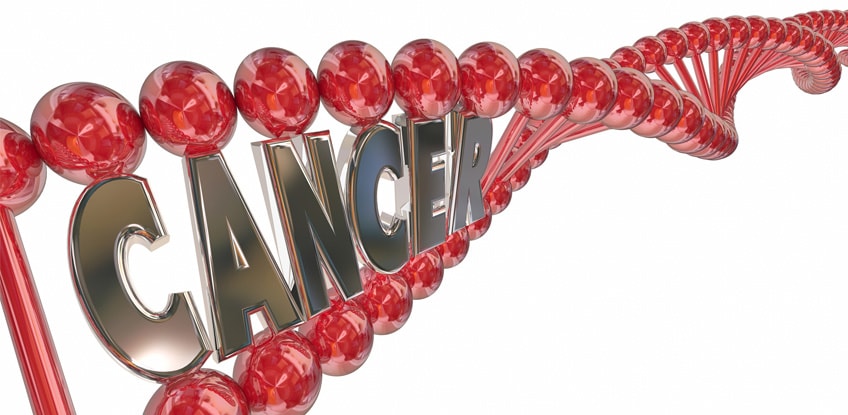BREAST CANCER RISK
In addition to personal and family history, there are two objective, measurable factors known to increase breast cancer risk: inherited genes and changes in the cells of the breast.
BREAST CANCER RISK FACTORS
There is one risk factor that cannot be modified and is associated with a predictably high chance of developing of breast cancer: deleterious or pathogenic genes inherited from your parents at the moment of conception. This is often referred to as your family history. It is becoming more and more apparent that in breast cancer, it’s all about the genes. As much as we’d like to believe that a healthy life style prevents cancer, it can’t alter your genes. Think about it: Can you change your eye color by exercising daily or eating healthy food?
What causes breast cancer?
Inherited forms of breast cancer tend to manifest early, when women are young and tend to occur in both breasts. They are typically more aggressive and resistant to treatment compared to non-inherited or spontaneous forms of breast cancer.
Having said that, the majority of women who are diagnosed with breast cancer do not have an inherited form of breast cancer. They may have a genetic predisposition but for the most part, 9 times out of 10, women develop breast cancer because of a spontaneous mutation.
FAMILY HISTORY OF BREAST CANCER
How would you suspect you had a mutation that could lead to inherited breast cancer? The first clue would be that you have a family history of breast cancer. There are women in your family that had breast or ovarian cancer or men with breast cancer or you had male or female blood relatives with cancer of the colon, pancreas, prostate (males only) or melanoma. The later is an example of the association between breast cancer and a family history of other cancers. There are several on-line tools you can use to determine your chance of carrying a mutation. See Risk Assessment Tools.
Genetic Testing for Breast Cancer
If you decide you want to undergo genetic testing there are several good companies to choose from. Your doctor can order the test or if you want, you can pay cash and do the test yourself. That way only you get the results. Companies that provide this testing approach usually have genetic counselors available and this service is included in the cost of the test. I strongly encourage you to use the counseling resource so you fully understand the test results and make healthy decisions for you and your family.
Patients can be tested for mutations specific to their situation or family history or they can be tested for a large panel of mutations (75+ genetic mutations). In addition to breast cancer, panel tests look at genes for other cancers such as colon, pancreas and melanoma. If you have a blood relative who had genetic testing and has a deleterious mutation you can be tested for just that specific gene. In this case you will need a copy of your relative’s test results.
Genetic testing requires that you provide a sample of your DNA and since your DNA is in every cell of your body, theoretically the sample can be taken from anywhere. Several years ago we used to draw blood in the office. Now we usually use saliva (the patient spits in a test tube). These genetic tests are very sophisticated (to me) and the results take 2 to 4 weeks.
Family History of Breast Cancer: A Case Report.
Recently in one of my Austin offices, I saw a new patient, Maria, age 32 who was just diagnosed with breast cancer. She had a biological sister, a sister who was adopted and a biological brother. The sisters wondered if they were more likely to get breast cancer and they decided they wanted genetic testing. In a scenario like this, it’s best to test the “affected individual”, in this case Maria. Based on our current knowledge (as of 2019) if Maria does not have a mutation her biological sister does have to be tested. However, the sister may still be high risk (see No Pathogenic Mutation below). If Maria has a deleterious mutation, the biological sister can be tested for the same specific mutation. The adopted sister does not have to be tested at all because she does not share Maria’s genes. Ideally, Maria’s brother (and all first degree relatives) should be tested for Maria’s mutation. Men who carry a BRCA mutation have a 1 in 100 chance of developing breast cancer so although a male is unlikely to ever manifest inherited breast cancer, each of his children will have a 50% chance of inheriting the mutation. Furthermore, many breast cancer mutations are also associated with other cancers such as colon, ovarian, prostate, etc. for which screening is available.

In general there are 3 possible outcomes of genetic testing.
A. Deleterious Mutations
Breast cancer genes can be inherited from your mother or father. There are even patients who develop a mutation on their own. The pattern of inheritance varies among the hundreds of know mutations but for patients with a BRCA 1 or 2 mutation, the mutation that we think is responsible for most forms of inherited breast cancer, the pattern is autosomal dominant. This means that if a Mother or Father has a BRCA 1 or 2 mutation, each child has a 50-50 chance of inheriting the gene. Other inherited mutations associated with breast cancer have different inheritance patterns.
Just because a person inherits a mutation doesn’t mean they will for sure develop cancer. The chance of manifesting the mutation varies among the different genes. For example, inheriting a BRCA 1 or 2 mutation is typically associated with a 40 to 80% chance of getting breast cancer. Inheriting a CHEK2 mutation, on the other hand, is associated with a 40% chance. If you test positive for a deleterious mutation, the lab report will state the currently known risk of developing cancer based on the specific mutation you have.

This is Angelina Jolie at a Movie Gala in Los Angeles, California in November 2015. In May 2013, the famous American actress announced that she had undergone a bilateral prophylactic mastectomy (preventive double mastectomy) to decrease her risk of breast cancer. She also had breast reconstruction. Angelina’s mother had breast cancer and later died of ovarian cancer at age 56. Angelina inherited a mutation in the tumor suppressor gene BRCA 1 from her Mother, placing her in a high-risk group for developing breast cancer in the future. Removing her breasts decreased Angelina’s risk substantially.
B. Variants of Unknown Significance (VUS)
Not infrequently, a genetic test will report that a patient has a Variant of Unknown Significance (VUS). This means there is a mutation but it is not associated with any know disease. In the case of a VUS the patient is not currently considered at high risk. However, over time, it may be discovered that the VUS is associated with cancer in which case ideally the genetic lab will notify the patient and the doctor who ordered the test. With this in mind, it’s important to keep your genetic test results in a safe place so they can found in the future.
C. No Pathogenic Mutation
If genetic testing did not find a pathogenic mutation in the genes tested for, a patient may still be at risk of developing cancer for the following reasons:
- Personal history
- Family history
- Not all genes associated with cancer have been discovered yet
- Current testing methods cannot detect all mutations
Remember: Don’t loose your genetic test results.The information may help you in the future and may help your family too.
Genetic Discrimination
When I started practice in Austin, Texas in the late 1990s, we were just beginning to use genetic testing in the clinical setting. Back then many patients were worried that if it were known they had a mutation that put them or their dependents at risk for cancer, they might be dropped by their insurance carrier. In 2009 in the United States, the Genetic Information Nondiscrimination Act (GINA) law went into effect. GINA made it illegal for health insurance providers to use genetic information to make decisions about insurance coverage or eligibility. GINA also made it illegal for employers to use genetic information when making decisions about hiring, etc. I am not an expert on this topic and no doubt there are many more aspects to the GINA law. I bring up the point to be thorough and make you aware of potential issues outside the scope of medicine. See this website for additional information.
Legal Website:
I my practice, the use of genetic testing is based on scientific evidence-based medicine and it is performed only after I have had an in-depth discussion with my patients. In this setting I cannot recall running into any discrimination obstacles and my patients have never reported any problems to me.
Would you want to know if you were destined to develop breast cancer?
Although you cannot alter your genes, you can alter the affect genes have on your breasts and thus change your destiny.

Stop Worrying About Breast cancer
Genetic testing is one of the most powerful weapons we have to fight breast cancer. I tell my patients that knowing they carry a mutation is a gift from a higher power because acting on that knowledge can prevent cancer. It will save your children too! You cannot change your genes but you can change the affect the genes have on your body. Genetic knowledge puts you in control of your destiny.

BREAST CANCER RISK FACTORS
Precancerous cells in the breast
WHAT CAUSES BREAST CANCER?
There are some changes in the breast tissue that can only be detected under the microscope and signify “field defects” in the breast milieu. These changes increase the chance of subsequent breast cancer.
These histological changes can increase a woman’s cancer risk 5 to 20 fold:
- Lobular carcinoma in situ(LCIS)
- Atypical cells as seen in atypical ductal hyperplasia, atypical lobular hyperplasia, and atypical papillary lesions
These histologic findings increase the risk of cancer but to a lesser degree:
- Radial scar (this has nothing to do with scars due to surgery or trauma)
- Papillary lesions such as a papilloma without atypia
How to Reduce Your Risk of Breast Cancer
If a woman has a breast biopsy and any of these histological findings are noted in the pathology report, she is at higher risk than the average woman of developing breast cancer. High-risk post-menopausal women taking hormone replacement therapy should stop or wean off the medication and ask their Gynecologist about non-hormonal alternatives. See the section on Prevention for recommendations about monitoring high-risk women and options for risk reduction.
RISK FACTORS FOR BREAST CANCER
Tests For Breast Cancer Risk
BREAST CANCER RISK ASSESSMENT TOOLS
There are several tools or models, many of which are available on-line, that use risk factors for developing breast cancer to predict the risk of having a genetic susceptibility to breast cancer, estimate the risk of developing invasive cancer, determine whether or not to use breast MRI as a screening tool, etc. Some of these tests can help you predict your chances of getting breast cancer if there is no family history. I have listed some of the Breast cancer Risk Calculators that have been validated (“proven” to be accurate) and therefore more likely to help a patient move on to the next level such as more in-depth observation or preventative measures.

A. National Cancer Institute (NCI) Breast Cancer Risk Assessment Tool
This prediction model is similar to the popular and user-friendly Gail Model. It has been around for a long time and has been validated for women from many ethnicities including Caucasian, Black/African American, Hispanic, Asian and Pacific Islander women in the United States. Note: There is limited data on American Indian and Alaskan women so their risk estimates are based on Caucasian women.
B. BRCAPRO
BRCAPRO assesses the probability that an individual carries a deleterious germline mutation of the BRCA1 and BRCA2 genes. Women with high BRCAPRO scores are more likely to have genetic testing covered by their insurance provider.
C. Tyrer-Cuzick Model
This model uses family history, exposure to estrogen and benign breast diseases to estimate the lifetime breast cancer risk. Most authorities (including insurance companies) consider a woman high risk if her lifetime chance is greater that 20 percent (in other words, greater than 1 in 5) according to the Tyrer-Cuzick model. These high-risk women may be eligible for more comprehensive screening such as breast MRI in addition to annual mammogram and physical examination. They may also be eligible for chemoprevention or preventative surgery (see Prevention).
